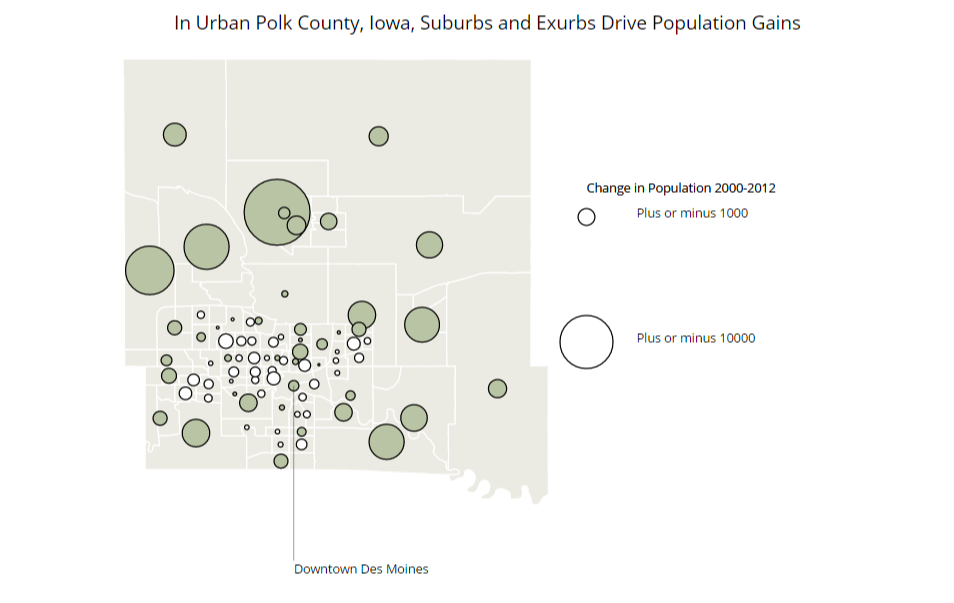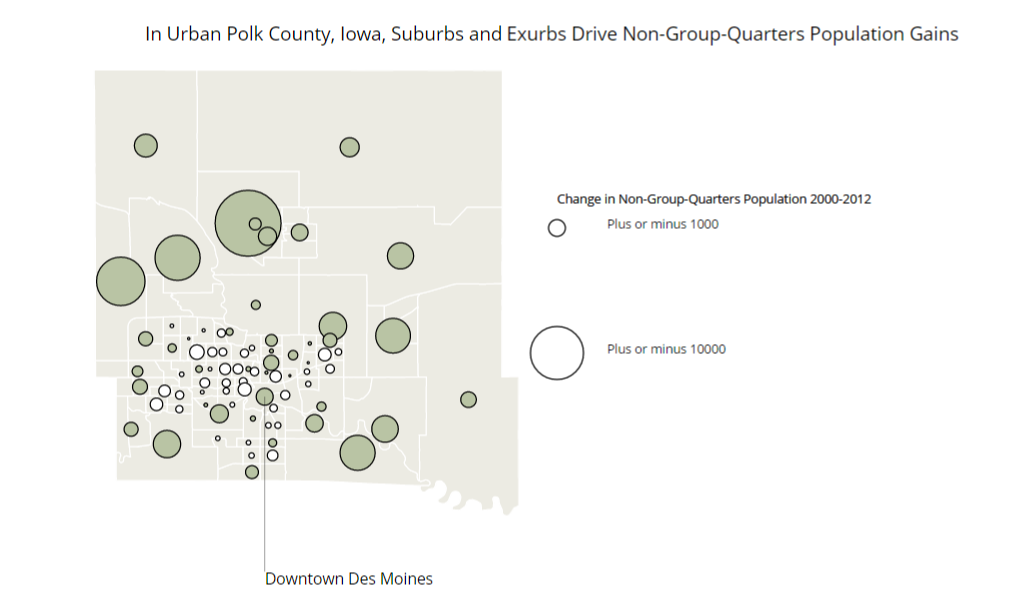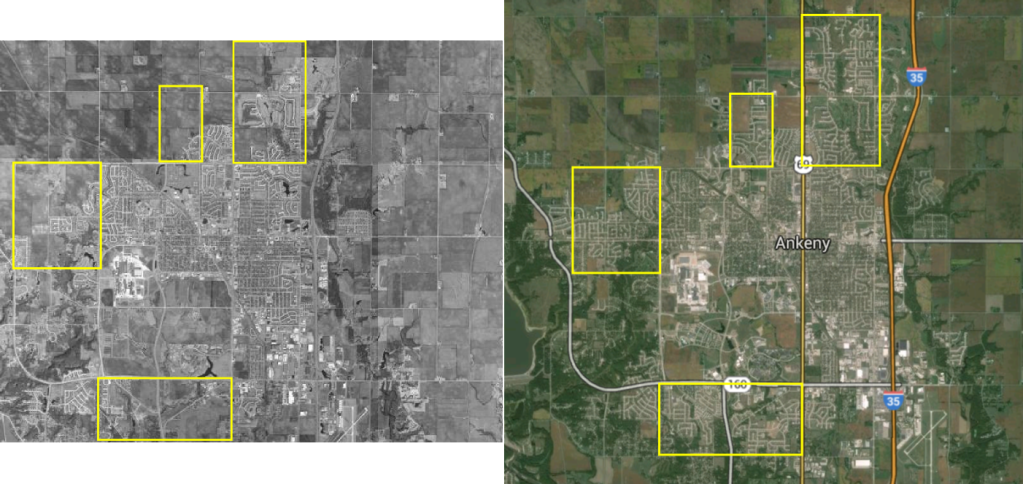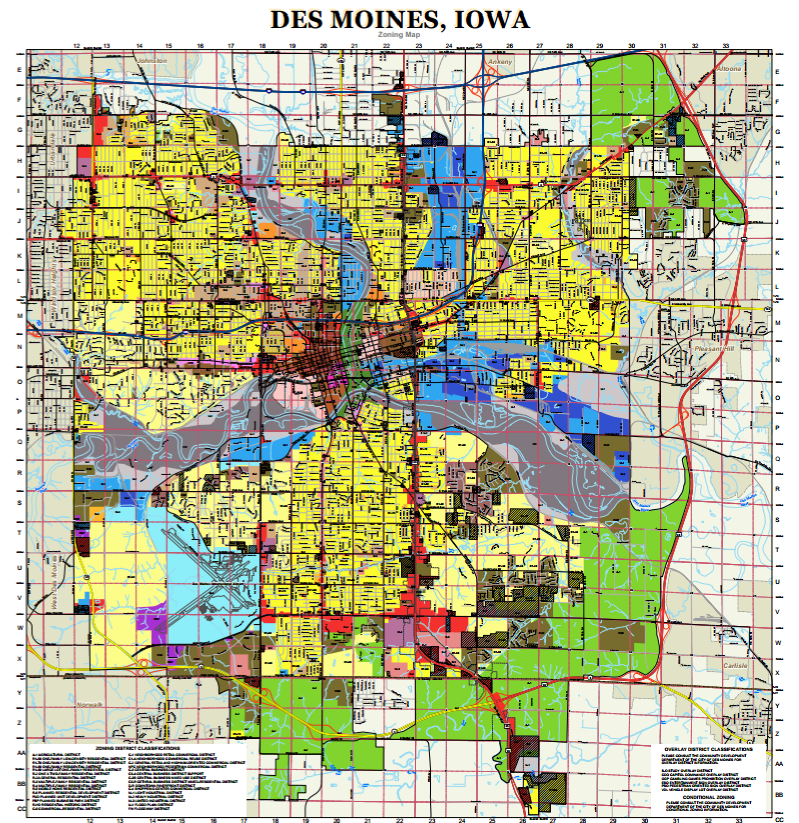A few weeks back, New York Times reporter Michael Barbaro published an article "With Farms Fading and Urban Might Rising, Power Shifts in Iowa", looking at the state's demographic changes with an eye on the closely-watched Senate election between Bruce Braley and Jodi Ernst.
I don't have any issue with most of the article–certainly I have no reason to dispute the qualitative reporting, and most of it corresponds to a quantitative picture I have no reason to dispute either (and I should add Mr. Barbaro kindly discussed the piece on Twitter with me). My main concern is with the false equivalence it sometimes suggests–the false equivalence of "urban" and "downtown city core".
Mr. Barbaro (who does mention suburban and exurban growth in other parts of his article) follows a section called "Rural Collapse" with a section called "Downtown Revival", mentioning technology start-ups and profiling a fellow named Mickey Davis, a manager for "the Des Moines Social Club, an art and performance space in downtown Des Moines":
"The population downtown has doubled over the past decade, and 1,500 new units of housing are planned. As a result, Des Moines’s home, Polk County — where registered Democrats outnumber Republicans by about 20,000 and President Obama’s margin of victory widened between 2008 and 2012 — is growing even more influential in statewide politics."
Given this context, you might well think that Polk County has had so much growth "as a result" of growth in downtown Des Moines. But, looking at the same kinds of Census and American Community Survey figures used by the Times, I don't see it.
(There’s an interactive version of this article here.)
Here is the graphic (by Haeyoun Park) the Times used: 
I liked this graph so much I decided to make my own, using the same files as from my article on Dallas County, Iowa. Here's the first one I made, but at the Census Tract cluster level, and limited to Polk County (note that this map doesn't distinguish between people in "group quarters", such as prisoners or college students, and the rest of the population): 
I don't see how downtown could have "doubled over the past decade". As far as I can tell, downtown Des Moines is basically coterminous with Census Tract 51, which I've labelled on the map. Tract 51 grew from a population of 4,175 in 2000 to a population of 4,553 in the 2012 estimates. Still, I noticed the group quarters thing was actually relevant here–Tract 51's population in group quarters dropped from 1,395 to 752, so the non-group-quarters population actually increased from 2,762 to 3,801. Even using that standard, that's a 38% increase, not a 100% increase or "doubling". But just to be safe, here's a map of the non-group-quarters population:
Downtown's Tract 51 does show a pretty large increase once you remove the group quarters populations (I believe there is a prison there), and a couple of adjacent tracts have grown as well. Certainly, growing is better than shrinking, as many Census Tracts in Des Moines proper did. But I think it's pretty clear that downtown isn't a particularly large driver of population growth across Polk County.
What areas have shown dramatic growth? The largest circle on either of my maps corresponds to Tract 102.03 in outer Ankeny. In 2000, this area was estimated to have a population of 4,910 (4,841 without group quarters). In 2012, Tract 102.03 was estimated to have a population of 20,350 (20,309 without group quarters)–more than quadrupling. In absolute terms, outer Ankeny's Tract 102.03 has added more than three times the total population of downtown Des Moines' Tract 51, and this increase accounts for almost one-fifth of Polk County's total population growth on its own.
I doubt a population increase of this magnitude could be some kind of pure Census artifact. But let's look for confirmation from other sources. Here's a satellite image of Ankeny, IA around 2002, taken from the "Iowa Geographic Map Server, along with a current satellite image of Ankeny from Google Maps. I've circled some of the areas that have obviously seen significant development over the interim (nearly all of which seem to be within the boundaries of Tract 102.03)–areas that looked like they were basically empty in 2002, but covered in houses now. Ankeny had seemingly empty space to expand into, and it did.
Looking at the zoning map of Ankeny (PDF), we can see that many of these high-growth areas are in or near planned urban developments (PUDs), with more PUDs zoned in some further peripheral or empty areas. Now let's look at the zoning map of Des Moines. In this particular zoning map, the yellow shades seem to all correspond to "R1" areas zoned for single-family units:
As you can see, the vast majority of Des Moines' land area is zoned for single-family units. There are certainly areas zoned for multi-family units scattered throughout Des Moines, but the only real concentration of them seems to be in the Central Business District area–nearly coterminous with Census Tract 51, as I said. There do seem to be some PUDs around downtown Des Moines, and I'm sure there's some infill and some commercial buildings being converted into residences. The non-group-quarters population did increase by over a thousand over twelve years, a pretty strong increase in percentage terms, if not all that much in absolute terms.
But in a city zoned like Des Moines (whether the zoning is reflecting or influencing preferences) how much can population growth come from "downtown revival" that many New York Times readers probably have in mind? From poking around on Google Maps, even neighborhoods a few minutes from downtown look more like suburbs–look more like Ankeny–than like your stereotypical walkable urban core full of lofts and coffee shops and so on. When most of the land area has to be single-family units, population growth would seem likelier to occur as it did in Ankeny, where new units are added at the periphery of the built-out area. This is more or less what seems to be happening from the Census Tract numbers as well. The large circles–the high-growth Census Tract clusters–basically form a ring around Des Moines proper.
It's certainly possible that the Census/ACS missed population growth in the "urban" parts of Des Moines proper. This requires further analysis, but it does seem like Des Moines proper, and downtown Des Moines in particular, cast far more Presidential votes in 2012 than in 2000 or 2004–perhaps an increase of 50% in Des Moines proper, and tripling in downtown. This doesn't necessarily reflect population growth missed by the Census/ACS, though–it might simply reflect the improved urban targeting and turnout operations associated with the Obama campaigns, perhaps along with a gentrifying (and thus higher-propensity) population in some areas. Again, I'm hoping to look into this further.
Whatever the details in Des Moines: Urban/metropolitan areas, cities proper, and stereotypical downtowns/cores/Central Business districts are certainly all connected, but they are also all different. Population growth or demographic shifts in a metropolitan area or urban county aren't necessarily driven directly by population growth or demographic shifts in that area's city proper or in that city's downtown core.



